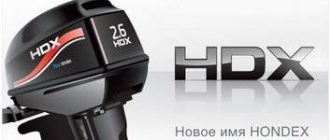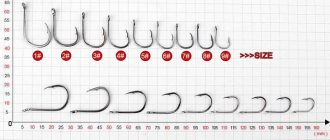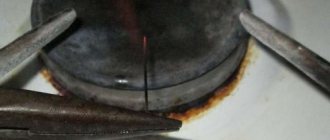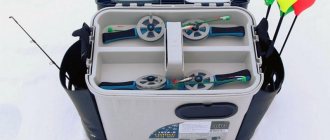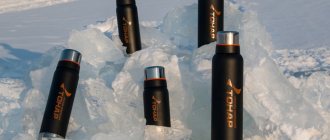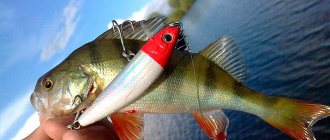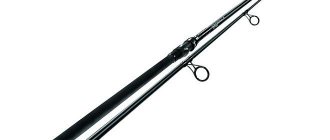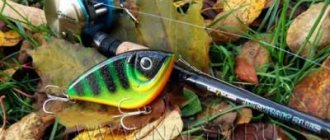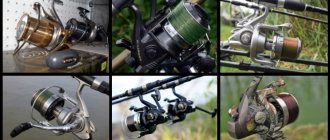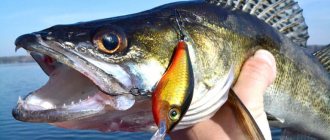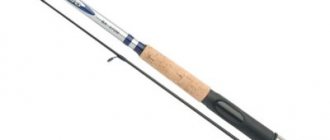Has it ever happened that you hooked the fish of your dreams, your heart quickens its rhythm, almost on a subconscious level you apply all your strength, experience and dexterity to pull this beauty ashore. You already see it! And suddenly she, waving her tail, swims away from you. Having taken out your tackle, you ascertain the fact that the hook is straightened. Well, all that remains is to shrug your shoulders and come up with a couple of excuses to reassure yourself. But you can go another way. Which one? Buy quality gear. In this case, Japanese owner hooks.
In this article we will look at the classification and description of fishing hooks. But first, a little about the company where this quality product is made.
Back in 1968, the now well-known company Owner . Soon, due to the wide demand for the product, there was a need to expand production, so in 1975, Owner moved to Tomita-town. Currently, the company produces its products not only in Japan, but also in the Philippines and China. I would like to note that the quality of the products was not affected.
By using the latest scientific technologies and collaborating with institutes that study the habits and anatomy of fish, the company has always managed to keep up with the times. Over the 49 years of its existence, the Owner company has been able to develop a simply huge variety of fishing hooks. In the catalog you can find hooks for any fish from giant sharks to roaches weighing several tens of grams.
Ovner hook manufacturing technology
The Japanese are a scrupulous and scrupulous people, and only thanks to these qualities they achieved the creation of fishing hooks of the highest quality, designed for each type of fish.
Before starting production, the company's employees conducted scientific research, in which they were assisted by scientists from a research laboratory studying fish.
Let's celebrate! Each fish has a certain structure, weight and shape of the oral cavity, and taking into account all these factors, Ovner specialists began to produce fishing hooks.
What material are hooks made of?
Thanks to innovative technologies, Ovner uses only the highest quality steel alloy to produce hooks. And this is a distinctive feature of the products of this company, which helps to inspire the confidence of fishing buyers to this day.
Also an important criterion is the thickness of the hooks themselves. Other manufacturers increase strength by thickening the diameter, but the Ovner company achieves strengthening not by thickening, but by introducing special innovative components into the steel alloy that add strength to the hooks without increasing the diameter.
Types of coatings
The types of hook coatings of this brand have distinctive features, depending on:
- series type;
- color design;
- design features.
Ovner brand hooks are coated in a variety of colors. It is this feature that helps anglers understand how durable this fishing device will be.
Distinctive features of the type of coating:
- Matte black/black chrome (BLACK/BLACKC HROME). Inspires the greatest confidence in anglers, has an anti-reflective effect with an increased level of strength and anti-corrosion treatment.
- Gold/oxidizing gold (GOLD/OXIDIZE GOLD). Brilliant or dull yellow color range for universal use.
- Tin (TIN). Vaguely reminiscent of the color of dark silver without shine, tinned coating.
- White/white oxidizing (WHITE/OXIDIZE WHITE). The high-gloss white finish is achieved by adding nickel to the alloy.
- Brown (BROWN). Alloy with added bronzer.
The following color ranges of coatings are innovative and have not yet received due popularity in our country:
- light purple (LIGHT PURPLE);
- green forest (FOREST GREEN);
- wood brown (WOODY-BROWN);
- red (RED);
- blue (BLUE).
Feeder hooks from Gamakatsu
So, we come to the third Japanese manufacturer of fishing hooks, Gamakatsu. It just so happened that Japanese wire has become one of the standards for quality fishing gear. The history of the company goes back more than 55 years. During this time, the company has undergone enormous development: from hand-made fishing hooks to several modern factories for the production of various fishing accessories (spinning rods, clothing, regular and special feeder lines, etc.). In the European market, Gamakatsu also operates under the Spro brand.
Many models of hooks from Gamakatsu are perfectly suited for feeders. Reasonable price and excellent quality attracts many fishermen. For feeder fishing I mainly use:
Gamakatsu LS-1010B Series – Very grippy hooks with minimal shedding. In my opinion, they have the optimal wire thickness. You can hang maggots, various grains and bloodworms on them. This series has a spatula and a brownish finish.
Gamakatsu LS-1040R Series – A catchy series with an extended fore-end, a spatula and a reddish tint. I use numbers 12 to 16 mainly for bream and crucian carp.
Gamakatsu 3510F series - like the previous two series, is very popular for feeder fishing. Short fore-end and slightly curved tip. Universal for various attachments. The most popular are No. 8-12.
Gamakatsu LS 3524F and F22 series - Perhaps one of the most successful series. The unusual shape and thin wire make them self-hinging. Most often I use No. 8-16. They are excellent for catching silver bream, crucian carp, carp, bream, and roach with feeder gear. It is very good to use pearl barley grains on them. I usually plant (depending on the number) 2-5 pieces. The shape facilitates good swallowing of this bait by the fish. You can successfully attach a worm and make combinations of several attachments. The only negative is that it cuts the lip of decent specimens of fish.
Gamakatsu LS-3614 F Series – Universal hooks. Almost any bait. They hold their edge well, the thickness of the wire copes with good specimens of fish.
Gamakatsu G-Method Feeder and Feeder Strong Series - Specially designed series of feeder hooks. Very good hooks too. They hold their edge well and are versatile for attachments.
Names and digital codes of Ovner hooks
With a huge range of products, each unit has its own name and a specific digital code. It doesn’t make much sense to describe in detail each of the huge assortment (more than two hundred items).
Model encoding includes:
- series title;
- type of hook;
- applied color coating;
- What kind of fish can it be used for catching?
More detailed information about encoding can be found in the specialized catalog, which should be provided by all reputable companies involved in the sale of this brand.
The range of Ovner brand hooks includes small and large models and a special measure for measuring the size of hooks has been developed for them:
- in small models, the largest number will correspond to the smallest size;
- in large models the numeric numbering is only fractional and the largest number will indicate the smallest size.
Gear manufacturing company
The Japanese company Owner has been producing fishing hooks for over fifty years. Despite the changing styles and methods of fishing, new requirements for gear, products under this brand keep up with the times. The technologies and developments used allow us to produce high-quality and competitive products.
Many bait manufacturers install Ovner offset hooks on their products, the catalog of which is constantly expanding. Despite new products from other manufacturers steadily appearing on sale, the products of this particular brand are in constant demand. Even when other items appear in the range of manufactured products, it is tees and other fish hooks that are the basis of the company’s sales.
Types of hook sharpening Owner
To date, only two types of sharpening are known that can be used on Ovner brand hooks:
- Cutting point (CUTTINGPOINT). Since the company is Japanese, this type of sharpening is based on the principle of giving sharpness to a samurai sword. This feature is unique to the Ovner company. Hooks sharpened to the principle of a sword have the properties of an instant cut, which can prevent you from catching fish with soft tissues in the perioral cavity. And for fish with hard near-mouth cavities, this type of hook is simply ideal.
- Needle point precision (SUPPER NEEDLE POINT). This type of sharpening, as the name suggests, hits the target without causing injury to the skin of the fish’s mouth and will only contribute to a good catch.
Owner products for fishing
Whatever the type of gear, its basis has always been and remains steel of increased strength and reliability. When developing, the company's experts consult with ichthyologists from Japanese scientific institutes on the specific behavior of fish during hunting and feeding. That is why in the lines, which include simple and offset Owner hooks, there are so many highly specialized tackles.
Designations on the packaging
Even the most experienced fisherman will get confused in the variety of products. For orientation, you need to figure out what the inscriptions on the packages or boxes with the goods will say:
- The name of the series is always written in full, without abbreviations, in English.
- From the five-digit number under the name you can find out the article indicating the coating of this product.
- The large number indicates the size: from the minimum 5/0 to the giants at number 22.
- Next comes the diameter.
- The number of hooks in the set is written after the words QTY or Quantity.
Sharpening technique
The manufacturer pays special attention to this indicator and its quality. One of the following methods can be applied to the main models:
- The innovative and original Cutting Point technique, which allows you to create three or more cutting edges, allows you to catch large specimens with powerful jerks. This type of sharpening penetrates the hardest jaw. When hooking and throwing prey ashore, you should be very careful.
- The simplest option is called Supper Needle Point. It also ensures a secure hold on the fish with minimal slippage.
Episode overview
This classification is very numerous and allows you to navigate the belonging of equipment to a particular fishing method or size of prey. For example, when you see a blue hook with a spatula and number 50001, you should know that this is gear for not very large fish with a convenient attachment of grains or worms. In addition to this, there are the following series:
- With a short forend and a ring bent inward, number 50152. They are characterized by feeder fishing with baits made of hominy, pearl barley or maggot.
- Donka or float works well with thin tips of the 50188 series.
- Feeder hooks 50282 and 50286 have a spade and are suitable for piercing bloodworms.
- The 50340 family is characterized by Gold (Oxidize Gold) or Black Chrome coatings.
- Sharp, with a bent tip, tackle number 50344 is universal, suitable for any bait.
- Winter fishing and the use of donkeys are possible with hooks 50354.
- It is convenient to plant worms on the number 50457.
- Hooks 50922 have a ring and a round bend, suitable for catching medium-sized fish.
On the company's official website you can find more detailed information and select the product you need at a particular moment.
Design features
In addition to sharpening, all products have their own technological characteristics aimed at making fishing easier and more comfortable. For example, if the package has the designation Small Bard, then such equipment has a reduced barb, which minimally injures the fish when hooking, as do hooks with the letters Twisted and a sting bent to the side. Hooks with a pressed barb, which are effective for fishing without slipping, are made using Press Bard technology, and gear with the Forged index has a forged hook. Geometrically balanced tees are called STB (stinger balance).
There are also two more categories - Ringed and Oval Ringed. The first represents the most popular method of fastening to round rings, and the second has oval rings, suitable for making streamers on tubes. In the case where none of the two previous designations is indicated, the tackle is tied by the shoulder blade. This method is a little less common due to a special unit that not everyone can make.
Types of coatings
There is also great variety in the color options available and the durability of the paint application. The most stable is Black Chrome - a special coating with anti-corrosion properties. Color black or dark chrome. This makes it possible not to cast reflections under water. The weakest coating was labeled Red. Between them, in descending order, are the following categories:
- Tin - with tinned coating.
- Gold and Oxidize Gold are golden in color and can be used for fishing in freshwater and saltwater.
- Nickel plated White and Oxidize White.
- Bronze Brown.
- Light Purple - soft lilac and Forest Green - green.
- Blue - blue and Woody-brown - woody green.
Such a wide selection makes it possible to optimally purchase a hook for fishing conditions at any time. For domestic fishermen, the most familiar are black, golden and tinned tackle.
The rest of the hooks seem too exotic to them, although in many cases their use would be much more practical.
Owner Fishing Hook Design
Each Ovner brand hook has a specific design feature, which can be identified before purchasing by the special logo on the front side of the package:
- Small barb (SMALL BARB). This hook design has a small bent protrusion in the form of a spike, which allows the fish, when swallowing the bait, not to fall off the hook.
- Twisted (TWISTED). The tip in this design is turned to the side, which has a beneficial effect when cutting.
- Fake (FORGED). This design is equipped with a forged base, which increases the strength even when using less thick wire.
- Pressed spike (PRESS BARB). This design has a pressed-in spike, which increases the efficiency of fishing without derailment.
- STINGER BALANCE. Only tees are designated for this design and the abbreviation STB will be printed on the packaging. Each of the three hooks has exactly the same dimensions and curves.
- RINGED. The design of this type is equipped with a ring type of fastening.
- OVAL RINGED. Judging by the name, it is clear that the mount will look like an oval.
Note! The absence of designations on the packaging for the last two design features can only mean the presence of a blade-type fastening.
Determining the size
Every novice angler should be well versed in the gradation of this element of gear. The package with the hook must contain encrypted information regarding all the data that will be needed in order to make an informed choice. This is a set of alphabetic and numeric characters. If you know what each of them will mean, then you can easily determine how long the hook is, how thick its shank and width are.
It was experimentally determined that the most universal are numbers 5 and 6
The marking begins with Roman numerals, which indicate the following information:
The next number indicates the width of the hook in millimeters. The last numerical value indicates how long the forend is.
In the domestic numbering of hooks, the smallest one is the one numbered 2.5. Amateur fishermen nicknamed it “swallow”. Its size is small, and it looks quite elegant. Suitable for fish with a small mouth, usually used for flies, maggots and other small baits.
To catch fish of larger sizes, as well as for experimenting with baits, you can use hooks with numbers 3 and 4. However, it was experimentally determined that numbers 5 and 6 are the most universal.
You can catch perch, small pike, carp, large crucian carp, bream and so on. For trophy specimens, even larger products will be needed - carp, grass carp and other large species are already caught with them. Catfish will require the use of only large hooks - the largest that can be found on sale.
Owner hook series
The company has divided all the hooks it produces into specific series, which significantly helps to make it easier for fishermen to select the necessary fishing equipment.
The range of each series is very large, so the most popular types will be considered below.
Single hooks with spatula

- AKITA SODE are available in blue and are ideal for fishing for roach and chub with filamentous algae bait.
- AKITA KITSUNE is available in bronze color. The ideal bait would be bloodworms and maggots.
- AKEMI-CHINU-BH is available in black colors, ideal for bottom or feeder fishing.
- AGI-B comes in a gold color scheme, ideal for more delicate baits without causing too much damage to them.
- ISADA is available in white color scheme. The ideal bait for these hooks would be grains of cereals or legumes. Float fishermen will be able to appreciate this device.
- ISEAMA is available in white, black and gold colors. This series is universal and suitable for any type of fishing.
- CUT-KAWAHAGI is available in gold and black chrome colors. Ideal for making jigs and using bait from Chernobyl and burdock.
- KAWAMUSHI is available in bronze color. The ideally shaped handguard allows you to hold the bait in strong currents.
- KAPPASTYLE2 is available in bronze color. The presence of a small spike prevents the fish from leaving, which is a big plus when fishing with a float.
- KAIZU comes in black and is designed for fishing for a specific fish - bream.
Single hooks with ring
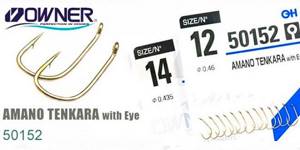
- AMANO TENKARA is available in bronze color and is ideal for making jigs with an eye.
- ISEAMA WITH EYE is available in black chrome. Ideally works for predatory and herbivorous fish species.
- K-BEAK is available in gold and black chrome versions. Ideal for fishing for large fish, especially carp.
Double hooks

- The DH-41 has a tinned coating and is ideal for catching large predators, including catfish. For bait you can use a frog or a sparrow.
- SD-33TG gold titanium coating gives this series special durability. Ideal for rigging jigs or live bait.
- TW-01 in black chrome color is universal due to its low specific weight. Ideal for rigging a walker, popper or wobbler.
Hooks tees
- ST-11UL in black chrome color are miniature in size and suitable for equipping the lightest baits. Ideal for winter fishing and rigging a spinner, balancer, or jig.
- STBL-36 in black chrome color. Ideal for fly fishing.
Manufacturing technology and materials of Owner hooks.
For the manufacture of absolutely every hook of this brand, steel with a high strength coefficient is used. The Owner company consistently ranks first in the market in terms of the popularity of its products.
This is achieved through a comprehensive study of the needs of consumers, in this case fishermen. Most fishing enthusiasts believe that each type of fish needs its own hook.
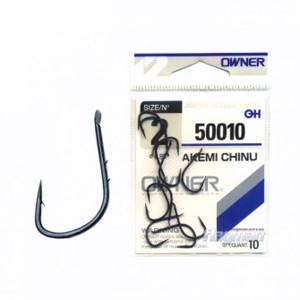
And this company satisfies this whim with pleasure. On the shelves of specialized stores you can find products for every taste, able to please even the most fastidious professionals.
Each type of fish has its own principle for gripping bait. It was this fact that gave the manufacturer the impetus to develop as many varieties of bait as possible.
For the convenience of fishermen, each Owner pack contains a detailed description of the product characteristics, which allows you to accurately select the required product.
On the pack with hooks you can see detailed graphic and analog symbols that reveal the full potential of fishing tools.
Types of coatings used to strengthen products:
- Gold coating. It is one of the most common. Has little resistance to salt water.
- Black Chrome. Known for the use of anti-corrosion coating, it is black in color. This coating makes it possible to fish in both fresh and salt water. It is rightfully the most reliable of the existing coatings.
- Nickel plated . It is second in strength after Black Chrome.
- Tinned coating . Very common. It cannot boast of particular reliability, but it is quite affordable.
How to distinguish original Ovner hooks from fakes?
Like many of any particularly popular products, the products of the Ovner brand are subject to plagiarism. And when buying hooks, you can run into fakes.
In order to avoid this annoying misunderstanding, you should remember the most important distinctive features of the information applied to branded packaging with hooks:
- On the back of the package, above the barcode, the model range and hook size must be indicated. Identical numbering must be applied to the front side of the package;
- The company's production facilities are located not only in Japan itself, but also have subsidiaries in China and the Philippines. Based on this information, on the original packaging in the lower right corner of the back of the package it will be written: “Product of Japan” (if made in Japan). On packs produced by subsidiaries, the information only looks like this: “Materials from Japan. Made in Philippines/China" (the country will only be indicated in which the hooks were made;
- odd numbering of hooks, produced by the Ovner company, exists, but is extremely rare (specialized products produced in small batches);
- on the lower right corner of the front side of the package the number of hooks in this pack is indicated;
- the information indicated on the front side must clearly coincide with the information in the official catalog or website of the Ovner company (name, code, color scheme, size);
- compliance of the information on the packaging with its internal contents;
- the cost of the cheapest hook of this brand cannot be less than one hundred rubles.
Note! If all of the above parameters are consistent, then we can say with confidence that the fisherman has branded products in his hands, and not a copy of them.
Hook numbering system
There are a lot of little things in fishing. And it would seem impossible to take them all into account. But I would say that this is the opinion of the loser lovers. There are no trifles in SUCCESSFUL fishing, because it is taking into account minor subtleties that is the key to success, distinguishing a pro from an unlucky beginner. Even the size of the hook can make a difference. Choosing the wrong hook, literally the wrong number for 1 size, can already cause failure. So, let's look at the hook numbering and the selection of certain hook sizes for different occasions, fish breeds and types of fishing.
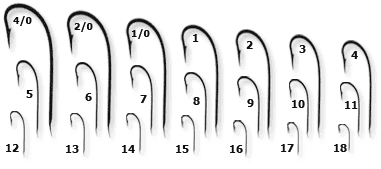
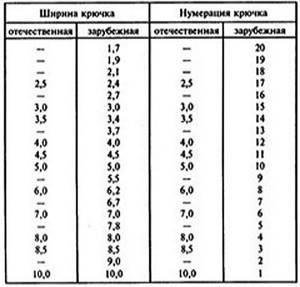
So, the smallest hook numbers : No. 2.5 - so-called. “swallows”. Thin, elegant hooks. They are used extremely rarely for fishing with a small-sized bait, the same small fish, with a miniature mouth. Once in my childhood, I used such hooks to catch crucian carp the size of a finger, in a pond where there were only these crushed crucian carp - no larger than 10 cm... You can also use such hooks to catch sebel in the river with flies and maggots.
Hooks No. 3-No. 4 are good for catching small and medium-sized fish (roach, silver bream, small crucian carp) with various baits.
No. 5-No. 7 are perhaps the most universal hooks that can be used to successfully catch: perch, small pike, small and medium-sized carp, large crucian carp, roach, bream, tench, etc.
Large numbers of hooks are for carp, large carp, and bream. The biggest hooks are for catfish.
Reviews of Ovner hooks
For the feeder I use only the Penny Hook 50921 No. 10 series. Ideal option for me. Grade:
Vasily N., Smolensk
I long ago decided on 50921 and 50922 No. 14 (very rarely, but I still use No. 16 and No. 12). The result is a bream of more than two and a half kg! Grade:
Sergey, Bryansk
Lately, my favorite series has been StrawHook53157 #10. Simply great! Grade:
Kirill, Smolensk
Almost eighty percent of the hooks in my arsenal are overners. Sharpening and quality at the highest level! Grade:
Artem, Sovetsky
After I read about Overner hooks on the Internet, I immediately decided to buy them, and I don’t regret it one bit. I haven't found everything I wanted yet. But I will definitely buy it. Grade:
Ratibor, Volodarsk
Note! Based on the description and reviews from fishermen, we can say with confidence that at least one of the Ovner brand hooks should be in the arsenal of any self-respecting fisherman.
Fishing Hook Size Charts
Today, two main hook numbering systems have become firmly established among fishermen:
- Soviet (domestic)
- international (western).
It's easy for an inexperienced beginner to get confused. And while studying the store catalog, you buy absolutely the wrong hooks that are needed. However, Russian and international numberings do not exhaust the entire topic. Although for us they are closer and more convenient than all the others.
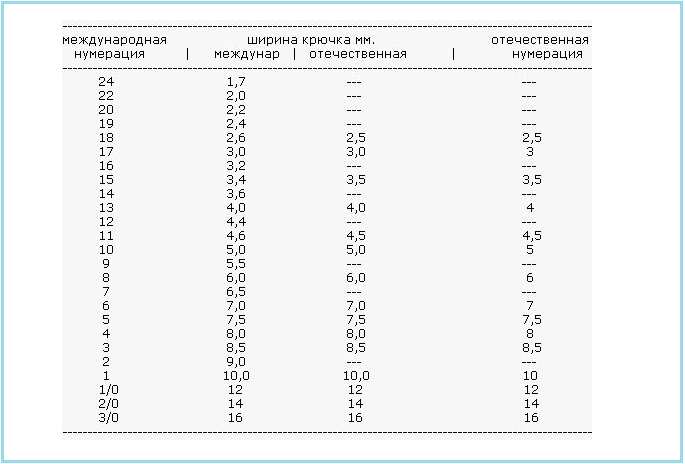
There are also Finnish and Japanese numbering. See the table with sizes and corresponding numbers for each classification below.
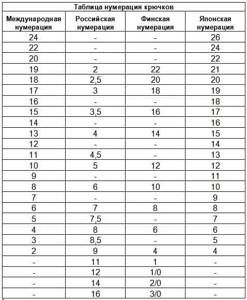
Types and shapes of fishing hooks
In addition, fishing hooks also differ in shape and purpose. It is clear that for catching bleak, single high-quality hooks are sufficient. In general, today the range of hooks in fishing stores is huge. Their terminology is also varied.
Single Fishing Hooks
It is important not only to choose the right fishing hook, but also to tie it to the fishing line. Here is an example of using hooks of various shapes. And also the influence of proper knitting on the comfort and success of fishing.

Here are the types of the most popular hooks among fishermen.
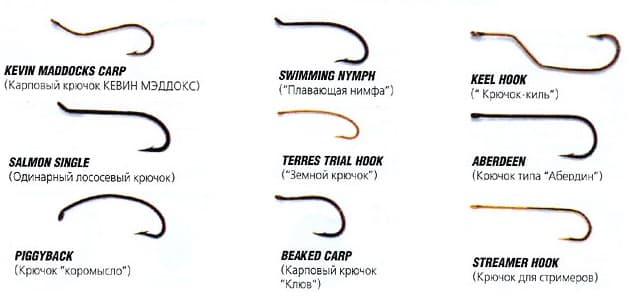
These are all single hooks. There are also doubles (twins) and triples (trebles). They are used primarily for catching river predators: pike, asp, pike perch, perch, etc.
Twin Size Chart
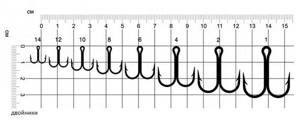
Tees numbers and sizes
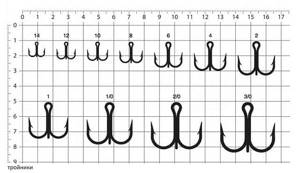
Types of sharpening
Owner fishing hooks have two types of sharpening. The first type is called Cutting point. This sharpening option was developed by the company specifically for anglers who prefer to catch predatory fish. Products with Cutting point sharpening are characterized by a triangular cutting edge and allow you to reliably cut through fish whose mouth consists of hard tissue. These hooks are indispensable when fishing for such types of fish as:
- zander,
- som,
- pike.
Products with a Cutting point sharpening are not recommended for fishing white fish whose mouth consists of soft tissue. When penetrating soft tissue, the cutting sting causes significant damage, leading to the rupture of the fish's lip and its removal from the hook.
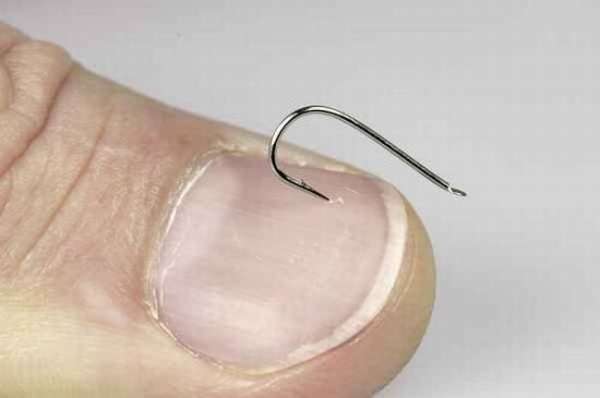
A well-sharpened hook digs into the nail without pressure.
Models with Supper needle point sharpening have a classic needle-shaped tip. Hooks sharpened with a Supper needle point cause virtually no damage when penetrating soft tissue, therefore, as a rule, they are used for catching white fish. Information about the type of sharpening is indicated on the packaging, thanks to which the angler can choose a model that will be optimally suited for fishing a certain type of fish.
